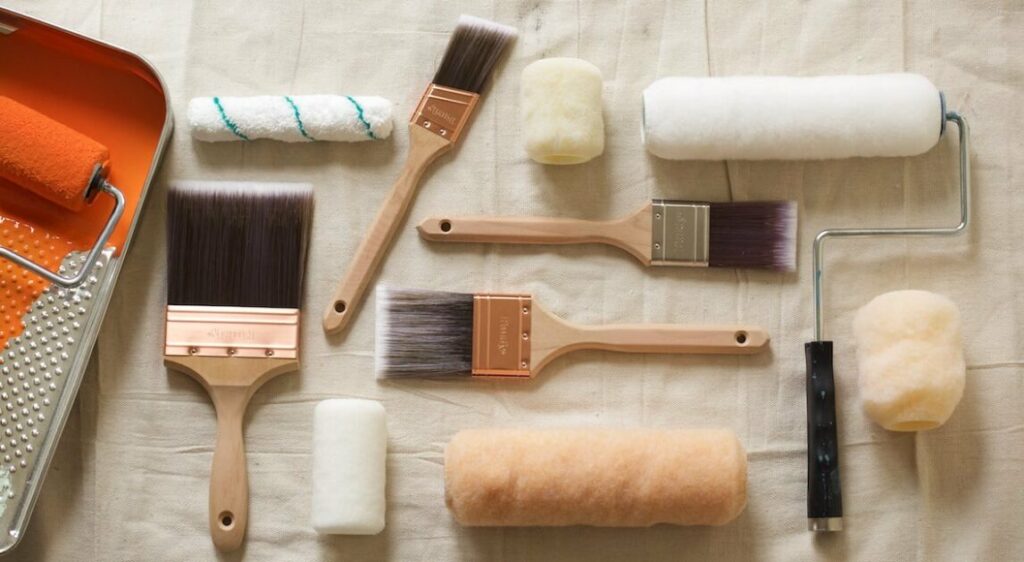A high-quality paint job doesn’t depend only on good paint, it also depends on the tools you use. Even premium paint can look streaky, uneven, or textured if the wrong brush or roller is chosen. Many DIY painters overlook this step and end up frustrated with patchy results or wasted time.
To achieve a professional finish, you need to know exactly which brush or roller suits your surface, paint type, and project size. Homeowners who want accuracy often turn to Painting Takeoff Services, which not only provide cost breakdowns but also recommend the right tools and techniques for a flawless result.
Why Tool Selection Matters
Choosing the wrong brush or roller leads to:
- Uneven coverage.
- Visible streaks or roller marks.
- Wasted paint.
- Shorter paint job lifespan.
On the other hand, using the right tool ensures smoother coverage, reduced effort, and longer-lasting results.
Brushes vs. Rollers: Key Differences
- Brushes: Best for detailed work, corners, trim, and smaller areas. Offer precision.
- Rollers: Best for covering large surfaces quickly and evenly. Save time and reduce streaks.
Most projects require a combination of both.
How to Choose the Right Brush
1. Bristle Material
- Natural bristles (hog hair): Great for oil-based paints and varnishes. Provide smooth finishes.
- Synthetic bristles (nylon/polyester): Best for latex and water-based paints. Resist water absorption and maintain stiffness.
2. Brush Size
- 1–2 inch: Trim, window frames, narrow edges.
- 2–3 inch: Doors, cabinets, medium surfaces.
- 3–4 inch: Large flat surfaces, siding, walls.
3. Brush Shape
- Flat brushes: Cover wide surfaces.
- Angled brushes (sash brushes): Great for cutting-in corners and edges.
- Round brushes: Ideal for detailed or decorative work.
4. Brush Quality
A good brush has flagged tips (split ends) that hold more paint and apply smoother strokes.
How to Choose the Right Roller
1. Nap Length (Thickness of Roller Cover)
- ¼ inch: Smooth surfaces (metal, plaster, wood).
- ⅜–½ inch: Lightly textured surfaces (drywall, ceilings).
- ¾–1 inch: Rough surfaces (stucco, brick, textured walls).
2. Roller Material
- Foam rollers: Smooth finishes, ideal for cabinets/doors.
- Synthetic rollers: Best for latex paints.
- Natural fiber rollers (lambswool): Great for oil-based paints and rough surfaces.
3. Roller Width
- 7–9 inches: Standard walls and ceilings.
- 12–18 inches: Large walls/exteriors for faster coverage.
- 4 inches or smaller: Trim, corners, small surfaces.
Common Mistakes to Avoid
- Using natural bristle brushes with water-based paint (they swell and lose shape).
- Choosing too short a nap roller for textured surfaces (leads to poor coverage).
- Using worn-out rollers that leave fuzz or lint.
- Overloading brushes and rollers with paint, causing drips and streaks.
Caring for Your Brushes and Rollers
Choosing the right tool is only half the job taking care of your brushes and rollers ensures they perform well for years. Neglected tools lose their shape, shed bristles, and leave uneven finishes. Proper cleaning and storage will save you money and keep your painting results professional.
-
Clean immediately after use: For water-based paints, wash brushes and rollers with warm soapy water. For oil-based paints, use mineral spirits or paint thinner.
-
Avoid soaking wooden handles: Prolonged soaking weakens the wood and loosens ferrules (the metal part holding bristles).
-
Spin or shake rollers dry: Excess water can damage fibers; spin them gently and let them air dry.
-
Wrap for storage: For short breaks between coats, wrap brushes and rollers in plastic wrap or aluminum foil to keep them moist without cleaning each time.
-
Store flat or hang bristles down: This maintains the natural shape and prevents curling.
With good care, a quality brush can last for years and a roller can handle multiple projects without leaving lint or streaks.
Matching Tools to Paint Finishes
Different paint finishes require specific tools to achieve their best look. A mismatch between finish and applicator can result in uneven shine, patchiness, or roller marks.
-
Flat or Matte Finishes: Best applied with medium nap rollers and synthetic brushes for even coverage without visible strokes.
-
Eggshell or Satin Finishes: Use high-quality rollers with ⅜–½ inch nap for smooth walls. Angled brushes work well for trim and corners.
-
Semi-Gloss and Gloss Finishes: These reflect light, so imperfections show easily. Foam rollers or fine synthetic brushes give the smooth, streak-free finish needed for doors, cabinets, and trim.
-
Textured Paints: Thick nap rollers (¾ inch or more) are necessary to reach into crevices and create consistent coverage.
By aligning the right brush or roller with the finish, you’ll enhance both appearance and durability.
Pro Tips for a Smooth Finish
- Pre-dampen synthetic brushes before use to help with smooth paint release.
- Rollers should be evenly loaded and roll off excess paint on a tray before applying.
- For ceilings, use an extension pole with a roller to reduce fatigue.
- Clean brushes and rollers thoroughly after use to extend their lifespan.
How Painting Estimating Services Help
Professional Painting Estimating Services go beyond cost breakdowns they recommend:
- The right type of brush and roller for each surface.
- Number of tools needed for efficiency.
- Paint quantity and labor hours based on project scope.
This guidance ensures homeowners avoid costly mistakes, save time, and achieve a professional-grade finish even with DIY efforts.
Conclusion
Choosing the right brush and roller is just as important as selecting the right paint. Brushes provide control and detail, while rollers ensure quick, even coverage on large surfaces. The right combination guarantees a professional-looking finish, reduced waste, and longer-lasting results. For maximum accuracy and expert guidance, consulting Painting Estimating can make the difference between a mediocre job and a flawless one.
FAQs
- Can I use one brush for all types of paint?
No, natural bristles work best with oil-based paints, while synthetic bristles suit water-based paints. - What roller is best for textured walls?
A ¾ to 1-inch nap roller works best for rough surfaces like stucco or brick. - Are foam rollers good for walls?
Foam rollers are better for smooth finishes on cabinets or doors, not large wall areas. - How long do good brushes last?
With proper cleaning, a quality brush can last for years. - Do rollers need to be cleaned or replaced?
Rollers can be cleaned and reused a few times, but for best results, replace them regularly.
- How to Choose the Right Brush and Roller for Painting?
- Discover the best paint brushes and rollers for your next project. Learn how to choose the right tools for smooth coverage and a lasting finish.
- Painting Takeoff Services,Painting Estimating Services
Related posts:
No related posts.




